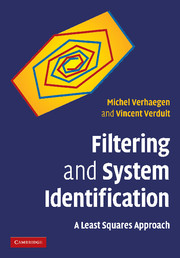Book contents
- Frontmatter
- Contents
- Preface
- Notation and symbols
- List of abbreviations
- 1 Introduction
- 2 Linear algebra
- 3 Discrete-time signals and systems
- 4 Random variables and signals
- 5 Kalman filtering
- 6 Estimation of spectra and frequency-response functions
- 7 Output-error parametric model estimation
- 8 Prediction-error parametric model estimation
- 9 Subspace model identification
- 10 The system-identification cycle
- References
- Index
Preface
Published online by Cambridge University Press: 14 January 2010
- Frontmatter
- Contents
- Preface
- Notation and symbols
- List of abbreviations
- 1 Introduction
- 2 Linear algebra
- 3 Discrete-time signals and systems
- 4 Random variables and signals
- 5 Kalman filtering
- 6 Estimation of spectra and frequency-response functions
- 7 Output-error parametric model estimation
- 8 Prediction-error parametric model estimation
- 9 Subspace model identification
- 10 The system-identification cycle
- References
- Index
Summary
This book is intended as a first-year graduate course for engineering students. It stresses the role of linear algebra and the least-squares problem in the field of filtering and system identification. The experience gained with this course at the Delft University of Technology and the University of Twente in the Netherlands has shown that the review of undergraduate study material from linear algebra, statistics, and system theory makes this course an ideal start to the graduate course program. More importantly, the geometric concepts from linear algebra and the central role of the least-squares problem stimulate students to understand how filtering and identification algorithms arise and also to start developing new ones. The course gives students the opportunity to see mathematics at work in solving engineering problems of practical relevance.
The course material can be covered in seven lectures:
(i) Lecture 1: Introduction and review of linear algebra (Chapters 1 and 2)
(ii) Lecture 2: Review of system theory and probability theory (Chapters 3 and 4)
(iii) Lecture 3: Kalman filtering (Chapter 5)
(iv) Lecture 4: Estimation of frequency-response functions (Chapter 6)
(v) Lecture 5: Estimation of the parameters in a state-space model (Chapters 7 and 8)
(vi) Lecture 6: Subspace model identification (Chapter 9)
(vii) Lecture 7: From theory to practice: the system-identification cycle (Chapter 10).
The authors are of the opinion that the transfer of knowledge is greatly improved when each lecture is followed by working classes in which the students do the exercises of the corresponding classes under the supervision of a tutor.
- Type
- Chapter
- Information
- Filtering and System IdentificationA Least Squares Approach, pp. xi - xiiPublisher: Cambridge University PressPrint publication year: 2007
- 1
- Cited by

